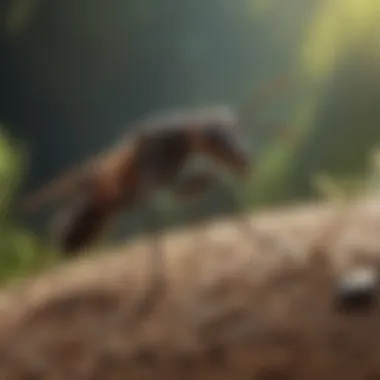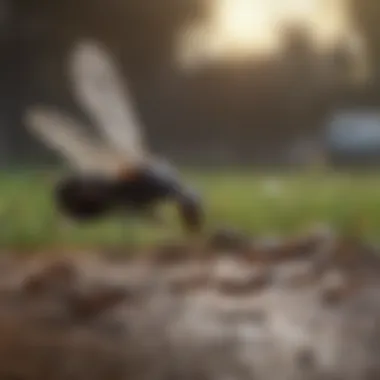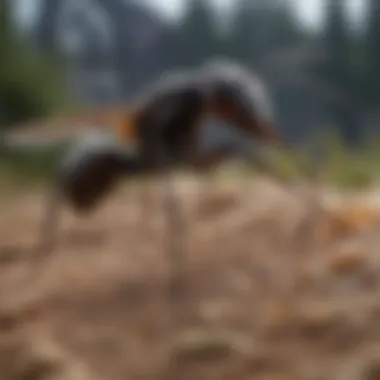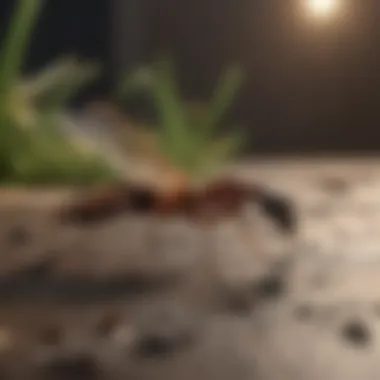Comprehensive Guide to Flying Ants in Houston


Intro
In the heart of Houston, residents find themselves often looking skyward as a peculiar parade fills the air. Flying ants make their annual debut, buzzing around in a show that might seem harmless but can be a harbinger of underlying issues. Understanding these insects—what they are, their lifecycle, and how they impact homes—can make all the difference when it comes to maintaining a comfortable living space.
This guide aims to uncover the intricate reality behind flying ants, equipping homeowners with the necessary insights and practical steps to keep these pests at bay. From identifying these winged visitors to employing effective prevention methods, let’s dive deep into the nature of flying ants and explore how they intertwine with everyday life in Houston.
Identification of Common Pests
Description of Common Pests
Flying ants are not a distinct species but rather winged reproductive members of an established ant colony, typically associated with various types of ants like carpenter ants, pavement ants, and others. Seen swarming during warm weather, it's easy to mistake them for termites. However, there are key distinctions: flying ants have a narrow waist, bent antennae, and two pairs of wings, with the front ones being longer than the back.
Signs of Infestation
Recognizing the signs of flying ants is crucial. Homeowners might see them indoors or around potential nesting sites, such as damp wood or alongside buildings. Look out for:
- Swarm Activity: Groups of ants in flight around your property, especially during humid or warm evenings.
- Wing Castings: After mating, males die, and females lose their wings, leaving behind shed wings near entry points or nest locations.
- Visible Colonies: Find out if you can see where these critters might be nesting by checking trellises, decks, or mulch beds close to the house.
"Flying ants often signal a colony’s spread. Understanding their habits can save you headaches down the line."
Prevention Techniques
Home Maintenance Tips
Keeping your home pest-free begins with sound maintenance routines. Consider these handy practices:
- Sealing Entry Points: Inspect doors, windows, and foundation cracks. Use caulk or silicone to seal any gaps where these pests might enter.
- Regular Cleaning: Ants are drawn to food sources. Maintain a clean kitchen and eliminate food scraps immediately.
- Proper Waste Management: Ensure trash bins are tightly sealed and place compost far away from your home.
Environmental Modifications
Making simple modifications in your yard can dissuade flying ants from making your home their own:
- Trim Vegetation: Keep trees and shrubs pruned so they do not touch your home, guiding ants away.
- Clear Debris: Regularly clean up yard litter and damp materials that can serve as nesting sites.
- Manage Moisture: Fix leaky pipes and ensure proper drainage to eliminate moisture that attracts pests.
Eco-Friendly Pest Control Options
Natural Pesticides
When it's necessary to act, opting for natural pesticides can safeguard your home while remaining environmentally conscious. Here are some options:
- Diatomaceous Earth: This non-toxic powder can be sprinkled in areas where ants are seen. It dehydrates them without harming the environment.
- Essentials Oils: Clove oil, peppermint oil, or tea tree oil can serve as repellents when diluted and sprayed around entry points.
Organic Pest Control Techniques
Utilizing organic techniques can sometimes offer long-term solutions:
- Boric Acid Mixture: A blend of boric acid, sugar, and water can attract and kill ants while being less harmful to pets and children.
- Soap and Water Solution: Sometimes, a simple mixture of soap and water can effectively eliminate ants when applied directly on them.
By fathoming the world of flying ants and employing strategic management, one can maintain a peaceful, pest-free sanctuary amidst the hustle and bustle of Houston life.
Prelude to Flying Ants
Flying ants can be a puzzling sight for many homeowners in Houston. On the surface, they may appear to be an annoyance, but understanding their existence can be quite enlightening. By digging into the intricacies of these winged insects, readers can gather practical knowledge about their behavior and lifecycle that is not just academic but beneficial for day-to-day living.
Recognizing flying ants, while not entirely complicated, opens doors to better pest management. With a little insight on what types might be fluttering around your backyard or even in your home, it’s possible to take the right steps to manage an infestation. This section lays the groundwork for understanding flying ants better. Here, we’ll cover what they are, and elaborate on common species found in Houston, alongside key distinguishing features that make their identification easier.


The importance of familiarizing oneself with these insects cannot be stressed enough. Knowledge empowers homeowners to recognize not only the presence of flying ants but also discern whether they pose a threat to their property or merely represent a transient occurrence in nature. Tackling flying ants is not just about managing pests; it's about maintaining a balance in our ecosystems. Let’s embark on this insightful journey to understand flying ants.
Lifecycle of Flying Ants
Understanding the lifecycle of flying ants is crucial for homeowners in Houston, as it sheds light on when these insects may invade living spaces and how one can effectively manage any potential infestations. The lifecycle can be broken down into distinct stages: egg, larval, and mature ants. Each of these stages carries specific characteristics that can help homeowners identify the presence of flying ants and take action before an infestation spirals out of control.
Egg Stage
The initial stage in the lifecycle of flying ants is the egg stage. After a successful mating flight, a fertilized queen will seek out a suitable place to lay her eggs. Typically, this is done in a secluded location, such as a crack in wood or soil. The number of eggs can vary widely, with a queen capable of producing thousands of them during her lifespan.
- Environmental Factors: Temperature and humidity play pivotal roles in egg viability, with warmer, moist conditions generally favoring egg survival.
- Incubation Period: The incubation period can last from several days to a few weeks, depending on environmental conditions.
During this time, it’s critical to monitor areas around the home that might serve as ideal nesting spots for queens. Noticing an increase in activity around locations where ants are more visible can serve as a red flag.
Larval Development
After the eggs hatch, the next phase in the lifecycle is the larval development stage. This phase can last anywhere from a few weeks to a couple of months, depending on the species and external conditions. The larvae are generally maggot-like in appearance, requiring care from worker ants.
- Nourishment Needs: Worker ants feed the larvae with a diet consisting primarily of proteins and carbohydrates, which they gather from various food sources. This feeding is vital for their growth.
- Environment: larvae thrive in dark, moist environments that shield them from predators and harsh weather conditions.
For homeowners, recognizing a surge of worker ants can be an essential clue. If you see them scurrying back and forth, they may be transporting food back to their larvae, indicating an active colony nearby.
Maturity and Swarming
Once the larvae mature, they will transition into adult ants. This stage is pivotal as it leads to the swarming events that commonly occur in warmer months, particularly in Houston's humid climate. Swarming typically happens in response to the right combination of warm temperatures and humidity levels.
- Swarming Process: The mature ants will take flight in search of mates, creating a spectacle that often raises concern for homeowners. Notably, this phase usually occurs in late spring or early summer.
- Post-Swarming: After mating, the males typically die, while the queens land, shed their wings, and seek a new location to establish a colony.
Important Note: It’s during these swarming events that many homeowners first notice flying ants in their homes.
Monitoring after these swarming events is crucial. Homeowners should look for discarded wings or the presence of emerging colonies, which can signal the beginning of an infestation and the need for effective management strategies.
Seasonality and Behavior
Understanding the seasonality and behavior of flying ants is essential for Houston residents keen on maintaining a pest-free home. Flying ants, particularly during their nuptial flights, can be seen in abundance at certain times of the year. Knowledge of these patterns can help homeowners anticipate their arrival and take proactive measures to manage or prevent infestations.
When to Expect Flying Ants
Typically, flying ants become visible in Houston as the weather warms up, particularly in late spring to early summer. This is the period when the environmental conditions are just right for their mating flights. They emerge en masse in response to rising temperatures and increased daylight, typically after rain showers. During this time, both male and female ants leave their colonies to find mates, which is a brief but significant part of their lifecycle.
Homeowners can expect to notice these swarming events, particularly on humid days, which can catch many by surprise. Being aware of these timings is crucial. Ants don’t just swarm at random; check local weather patterns closely around late May to June, as that is usually when flying ants start making an appearance.
Swarming Events
Swarming is a fascinating, albeit alarming behavior for homeowners. This is the time when virgin queen ants take flight to find suitable partners and establish new colonies. Swarming events can vary based on species, but they’re typically most prominent during late afternoons when temperatures peak. In Houston, after the first rain in warmer months often triggers these flights.
The sheer number of ants can be daunting, but it's important to remember that these swarms are temporary and part of a natural reproductive cycle. Once the mating is finished, the queens look for nesting sites, and the males typically die shortly thereafter. Understanding this behavior can help homeowners grasp the infestation timeline and take appropriate steps.
Environmental Influences
Temperature and Humidity
Temperature and humidity play a massive role in the behavior of flying ants. Higher temperatures signal the arrival of swarming season, as ants are ectothermic and rely on external warmth to fuel their activities. There’s an increase in activity when the humidity is high—this is critical for both mating and the survival of the brood. A significant feature is that the combination of warm temperature and moist air creates ideal conditions for these insects, allowing them to thrive. However, the downside is that high humidity can also lead to other pest problems in homes, arising from damp and humid environments.
Rainfall Effects
Rainfall has a twofold impact on flying ants. Firstly, it engenders them to take flight as it promises optimal moisture for nests. After a rainfall, the ground is softer, making it easier for queens to dig in and establish a new colony. Secondly, rainfall can sometimes lead to temporary flooding, which may displace ant colonies and create a surge in swarming behavior as ants flee from inundated nests. Homeowners should be particularly vigilant after heavy rains, as that’s when you may see a spike in flying ants and related activity.
"Understanding the environmental influences can be your first line of defense in managing flying ant populations in your home."
Armed with this knowledge, residents can better equip themselves to deal with the seasonal activities of flying ants in Houston.


Impact of Flying Ants on Homes
Understanding how flying ants affect homes is crucial for homeowners, especially those in Houston. These insects might seem harmless, but their presence can lead to significant issues if not managed properly. Ants are not just annoying; they can cause physical damage to structures and create health hazards. Awareness about how to identify the signs of infestations, their impact on health, and what preventative measures can be taken is essential for maintaining a safe and sound living environment.
Structural Damage
Carpenter Ant Infestation
Carpenter ants are notorious for causing structural damage to homes. Unlike termites, they don’t consume wood; rather, they excavate it to create nests. This behavior can lead to severe issues not just in the wooden structures but also in the overall integrity of the house if the infestation goes unchecked. An early alert to their presence is essential because once they take root, repairs can be quite costly and time-consuming.
One key characteristic of carpenter ants is their size. They tend to be larger than common household ants, typically ranging from 1/4 to 1 inch in length, with black, red, or a mixture of colors. This distinctiveness makes them easier to identify. Homeowners might find it easier to spot them when they witness their swarming behavior, usually during spring.
However, it’s important to note the disadvantage of ignoring these ants. By the time signs of damage become visible, significant destruction may already have occurred in hidden areas, making early detection vital.
Signs of Damage
Identifying signs of damage is fundamental in addressing carpenter ant infestations. Homeowners should keep an eye out for various indicators, including sawdust piles, which are a clear sign of their nesting and feeding habits. Another symptom could be the presence of small holes in wood, where ants have dug out to create their nests. It’s also worth mentioning that these ants might leave wings behind after swarming, a noticeable sign of prior activity.
The crucial aspect of recognizing damage is the ability to act quickly to mitigate further issues. If you notice any of these signs, it’s a call to action — to investigate further before it escalates. Ignoring these indicators might lead to an extensive and costly repair bill down the line.
Health Risks
Allergic Reactions
Not all flying ants pose health risks, but it's prudent to be aware that carpenter ants can cause allergic reactions in some individuals. When these ants bite, they can release enzymes that can trigger reactions, especially in sensitive people. This can lead to localized swelling, redness, and even itching. Staying informed about this possibility is key, especially for households with children or pets, who might be more susceptible.
A noteworthy feature of allergic reactions is that they can often escalate, meaning what starts as a simple bite could lead to more severe health issues for those predisposed to allergies. Understanding these risks can empower homeowners to take preventative measures, reducing their exposure to such incidents.
Contamination Concerns
The presence of flying ants in your home also raises the potential for contamination. These insects are scavengers by nature, and they can bring pathogens into homes from their search for food. Pest control experts emphasize that ants can unknowingly transport bacteria and other harmful substances, making kitchens and food storage areas potential hotspots for contamination.
Being aware of this can encourage proactive hygiene practices, such as cleaning up food spills promptly and sealing food containers securely. Additionally, it creates an avenue for homeowners to practice better pest management, ensuring that their living spaces remain clean and health-focused. If found in large numbers, infesting your kitchen could lead to potential health risks you may not initially associate with flying ants.
Effective Management Strategies
Addressing the issue of flying ants requires a calculated approach. Effective management strategies not only help to control existing infestations but also prevent future occurrences. The rippling effects of these strategies can bear greatly on homeowners' comfort and property value, making it essential to grasp their intricacies. Here, we will delve into identifying infestations, preventive measures, and control methods — each pivotal in maintaining a pest-free environment. Together, these strategies create a multifaceted plan that homeowners can implement with relative ease and confidence.
Identifying Infestations
The first step in tackling an infestation is recognizing the telltale signs that indicate flying ants have made their home in or around yours. Often, these include the sight of swarms, particularly during warmer months. Other indicators may be leftover wing fragments, small piles of sawdust, or the presence of their nests, typically found within walls or gardens.
Once aware, it is crucial to closely watch for activity during specific times of the day, mainly late afternoon or early evening. Initial spotting often leads to further investigation which can reveal the extent of the problem. Taking quick action can potentially save headaches down the road, as neglected infestations often flourish, leading to more significant issues.
Preventive Measures
Sealing Entry Points
Sealing entry points is a top-notch preventive measure homeowners can take to thwart flying ants from invading their space. This approach involves thoroughly inspecting one's home for cracks, gaps, or openings, particularly around doors, windows, and utility lines. Any identified entryway should be promptly caulked to eliminate access.
A key characteristic of sealing entry points is its efficacy in keeping not just ants but also other unwanted critters at bay. It’s a practical and cost-effective choice; after all, who wouldn’t want to invest in something that offers long-term peace of mind? While sealing may require a bit of upfront effort, the long-term advantages it presents — such as reduced pest problems and heightened home comfort — weigh against the inconvenience.
Regular Inspections
Regular inspections serve as a proactive method that homeowners can employ to detect early signs of flying ants before they become a full-blown problem. By scheduling periodic checks around the home and the premises—especially during peak seasons—homeowners can safeguard their living spaces.


The beauty of regular inspections lies in their simplicity. It offers control and peace of mind, empowering homeowners to stay ahead of potential infestations. However, it is worth noting that diligence is vital; overlooking these checks may let issues fester unnoticed, complicating matters in the future.
Control Methods
DIY Solutions
DIY solutions are appealing for their immediacy and affordability. Homeowners often resort to various methods for tackling ants on their own, using basic supplies like vinegar, essential oils, or even borax. Spraying these around known problem areas can deter ants and sometimes eradicate small colonies.
One notable aspect of DIY solutions is the sense of accomplishment they can provide, alongside financial savings. However, be wary — while these approaches may be effective for minor infestations, their reach is limited. Extensive infestations often require a more robust strategy, making it essential to assess the severity of the situation before diving in.
Professional Services
Professional services offer a well-rounded alternative for homeowners experiencing significant ant issues. Pest control experts can tailor solutions specific to the nature of the infestation and offer insights into prevention based on years of experience.
The advantage of professional services is their thoroughness. They not only address existing problems but also educate homeowners about ongoing preventative strategies. However, this option comes at a price, and some homeowners may feel apprehensive about inviting specialists into their personal space. That being said, the expense often proves worthwhile for peace of mind and thorough, lasting results.
Effective management of flying ants hinges on understanding how to identify infestations, implement preventive measures, and make use of control methods suitable for each specific situation.
Ecological Considerations
When discussing flying ants in Houston, it's essential to delve into the ecological aspects surrounding these insects. While they may be a nuisance at times, flying ants hold a significant place within the environment, contributing to ecological stability in ways we might often overlook.
Role in Ecosystem
Flying ants play a crucial role in the ecosystem, acting as both predators and prey. They are part of the food web; their presence supports various species that rely on them for sustenance. For example, birds and other insects feed on flying ants, helping to maintain a balance within the local ecosystem. This predator-prey relationship ensures that populations of various species remain in check, thus promoting a healthier environment.
Moreover, flying ants assist in the breakdown of organic materials. As they forage, they contribute to the decomposition of decaying leaves, wood, and other plant matter. This process enriches the soil, making it more fertile and conducive for the growth of plants. In fact, without such insects, the decomposition process would be significantly slowed, impacting plant growth and the overall health of the ecosystem.
Their nesting habits also serve biological functions. For instance, when flying ants establish new colonies, they aerate the soil, allowing water and nutrients to penetrate deeper, thus benefiting plant life in their vicinity. This kind of soil enhancement is crucial for urban areas like Houston where construction and pollution might lessen natural soil fertility.
Balancing Control with Biodiversity
Addressing the flying ant issue requires a careful balance between management and preservation of biodiversity. Homeowners often feel compelled to eradicate ant populations upon sighting them. However, it's vital to consider the repercussions such actions might have on local wildlife.
“Controlling flying ant populations can prevent structural damage but must be done thoughtfully to avoid harming beneficial species.”
A one-size-fits-all approach may lead to unintended consequences. Instead, focusing on integrated pest management strategies is key. Here are a few considerations to bear in mind:
- Target specific infestations: Rather than blanket pesticide applications, identify specific nests or swarming sites that need attention.
- Utilize natural deterrents: Employ environmentally friendly solutions, like diatomaceous earth or essential oils, that minimize harm to the surrounding ecosystem.
- Education and awareness: By understanding the importance of flying ants in the ecosystem, homeowners can make more informed decisions regarding pest management.
Maintaining a diverse ecosystem improves resilience against pests like flying ants. By fostering a healthy mix of plant and insect life, homeowners ensure natural controls are in place to manage pests without unnecessary chemical usage.
In summary, while flying ants in Houston can be seen as problematic, their role shouldn't be dismissed lightly. Recognizing their contribution to the ecosystem enables a more nuanced approach to managing and understanding these insects.
End
In wrapping up our comprehensive examination of flying ants in Houston, it’s essential to underscore the significance of being well-informed about these insects, particularly for homeowners and those managing properties. Understanding flying ants encompasses several facets: their identification, behaviors, lifecycle, and the potential impact they can have on our spaces. This knowledge is not just about recognizing a pest, but it's also about fostering a proactive relationship with your environment.
Summary of Key Insights
Through our detailed exploration, we’ve outlined that:
- Identification: Recognizing the different species, such as Carpenter Ants, Thief Ants, and Wood Ants, makes handling infestations far easier.
- Lifecycle: Knowing the stages from egg to maturity aids in understanding when to expect swarming and how to prepare for it.
- Impact: Awareness of the potential structural damage and health risks from infestations emphasizes the importance of early detection.
- Management: Proactive approaches—like sealing entry points and conducting regular inspections—can significantly reduce the chances of large infestations occurring.
In essence, these insights equip homeowners with the necessary tools to engage effectively in pest management, potentially saving both money and time, while keeping their homes safe and sound.
Future Trends in Pest Management
The landscape of pest management is continually evolving, guided by advancements in technology and changes in ecological understanding. Here are a few trends to keep an eye on:
- Eco-Friendly Solutions: There's a marked shift towards using organic and eco-sensitive products. Homeowners are now more concerned about the chemicals used in pest control, pushing for alternatives that are effective but less harmful to the environment.
- Integrated Pest Management (IPM): This approach combines multiple management strategies for a more effective and sustainable outcome. Techniques include habitat modification, biological control, and specific pesticide applications tailored to needs without disrupting the local ecosystem.
- Smart Technology: Innovations like pest detection devices and monitoring systems will allow homeowners to manage pest problems more efficiently. These tools can provide real-time data on ant activity, helping to catch potential infestations before they escalate.
Staying ahead of these trends will not only enhance pest control effectiveness but also contribute positively to maintaining the biodiversity and health of residential areas in Houston.







